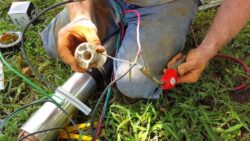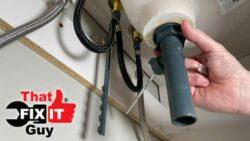Planning to install a gas line in your home? It’s important to prioritize safety and follow best practices to ensure a secure and reliable installation. This guide will provide you with essential tips and precautions to consider when installing a gas line, as well as helpful resources to guide you through the process.
Before diving into the installation, it’s crucial to obtain the necessary permits from your local government. These permits ensure that your installation meets safety regulations and standards. Additionally, familiarizing yourself with the gas line installation regulations specific to your area will help you stay compliant.
Calculating the proper size of the gas piping is essential for optimal functionality. Consulting a plumbing code book for the correct pipe sizing chart will ensure that you select the appropriate size for your installation.
When it comes to connecting the new pipes, make sure to use gas-grade plumber’s tape, pipe sealant, and a pipe wrench to create secure connections. These precautions will help prevent leaks and ensure the gas line’s integrity.
To confirm the airtightness of the installation, pressure-testing the pipes using an air compressor is crucial. Checking for leaks with the help of soapy water will enable you to identify any potential issues.
Key Takeaways:
- Obtain the necessary permits from your local government before starting the gas line installation.
- Refer to plumbing code books to calculate the appropriate pipe size for your installation.
- Seal connections with gas-grade plumber’s tape, pipe sealant, and a pipe wrench to prevent leaks.
- Pressure-test the pipes using an air compressor and check for leaks with soapy water.
- Consult a licensed contractor for tasks such as bonding the gas line and connecting gas-powered appliances that require both gas and electricity.
Types of Pipes for Gas Lines
When it comes to choosing the right pipes for your gas lines, it’s essential to consider the materials that offer the best performance and safety. Two popular options for gas line pipes are poly pipes and galvanized pipes.
Poly Pipes with Barbed Fittings
Poly pipes, also known as polyethylene pipes, are a common choice for gas lines due to their durability and flexibility. These pipes are made from high-density polyethylene (HDPE) and are resistant to corrosion and chemicals, ensuring long-lasting performance.
One of the advantages of poly pipes is their compatibility with barbed fittings. These fittings create a secure connection between the pipe and other components, preventing leakage and ensuring gas flow remains consistent.
It’s important to secure the barbed fittings with hose clamps to further enhance the connection’s integrity. Hose clamps provide an extra layer of protection against potential leaks and can be easily tightened for a secure fit.
Galvanized Pipes: Not Recommended
While galvanized pipes are commonly used for various plumbing applications, they should never be used for gas lines. Galvanized pipes are steel pipes coated with a layer of zinc to prevent rusting. However, this coating can strip off over time and cause flakes.
These flakes can potentially clog orifices and other gas line components, leading to decreased gas flow and inefficient performance. To maintain a reliable and safe gas line, it is best to steer clear of galvanized pipes.
Municipal Codes and Building Regulations
It’s essential to note that municipal codes and building regulations often prohibit the use of galvanized pipes for gas lines due to the potential hazards they pose. Always consult these regulations to ensure compliance and choose the appropriate materials for your gas line installation.
For a visual representation of the types of pipes for gas lines, refer to the table below:
| Pipe Type | Advantages | Disadvantages |
|---|---|---|
| Poly Pipes | Durable, flexible, resistant to corrosion and chemicals | None |
| Galvanized Pipes | Commonly used for plumbing | Coating can strip off, causing flakes that may clog orifices |
Keep in mind that choosing the right type of pipe and ensuring proper installation are crucial for a safe and efficient gas line system.
Gas Line Installation Tips
When it comes to gas line installation, it is crucial to prioritize safety and seek the expertise of a professional plumber or technician. Hiring a professional ensures that the installation is done correctly, minimizing the risks associated with improper installation.
Gas Line Layout
Before starting the installation process, it is important to familiarize yourself with the gas line layout. Understand the location of the shut-off valve and other important components for future repairs or leak detection.
Choosing the Right Pipe Material
Choosing the correct pipe material is essential for a reliable and durable gas line. Consultation with an expert can help determine the appropriate pipe material, whether it’s steel or plastic, based on local regulations and specific project requirements.
Turning Off the Gas
Prior to beginning the installation, ensure that the gas supply to the property is turned off. This step is crucial to prevent gas leaks and ensure the safety of both the installer and the property.
Sizing and Fitting of the Pipe
Proper sizing and fitting of the pipe are critical for the efficient and effective operation of the gas line. Consult with a professional to ensure the pipe is appropriately sized and fitted to meet the demands of the appliances and the overall gas system.
Testing the Airtightness of the System
Once the installation is complete, it is vital to test the airtightness of the gas system to detect any potential leaks. This can be done using specialized equipment that measures gas pressure or by applying soapy water to the connections and observing for bubbles, indicating a leak.
Testing with Appliances
Testing the functionality of the gas line with appliances should be done by a professional or someone with experience in handling gas systems. This ensures proper functioning and validates the installation’s effectiveness in delivering gas to the desired appliances.
Understanding Gas Line Safety
When it comes to gas line safety, there are important factors to consider such as the natural gas flammability range, odorant for gas detection, and the hazards associated with improper gas line installation. Understanding these aspects is crucial to ensure the safety of your gas line.
Natural Gas Flammability Range
Natural gas, a commonly used fuel, has a flammability range of approximately 5-15%. This means that when the concentration of natural gas in the air is within this range, it is flammable. However, mixtures of natural gas that fall outside this range will not support combustion. It is important to be aware of this range to prevent accidents and maintain a safe environment.
Odorant for Gas Detection
One challenge with natural gas is that it is odorless, making it difficult to detect leaks. To address this, an odorant called mercaptan is added to natural gas to give it a distinctive smell. Mercaptan has a strong, unpleasant odor that makes it easy to identify gas leaks. If you detect this odor, it is vital to take immediate action and ensure the safety of yourself and others in the vicinity.
Hazards of Improper Gas Line Installation
Improper gas line installation poses significant hazards, both in terms of health and fire safety. It is strongly advised not to attempt gas line installation as a DIY project without the necessary expertise and knowledge. Inadequate installation can lead to gas leaks, which can have serious health implications and increase the risk of fire. To ensure the safety of your gas line and those around you, it is crucial to entrust the installation to a professional who understands the complexities and follows proper safety protocols.
Gas Line Components
When it comes to gas line installation, understanding the different components involved is essential for a successful and safe setup. In this section, we will explore the key elements that make up a gas line system: the gas supply line, branch lines, drop line, riser, sediment trap, and dirt pocket.
Gas Supply Line
The gas supply line serves as the main conduit for natural gas, carrying it from the utility meter into the building. This line is typically made of durable materials such as steel or copper to ensure longevity and safety.
Branch Lines
Branch lines are responsible for distributing the gas from the main supply line to individual appliances throughout the building. These lines connect to the gas supply line using suitable connectors and fittings, ensuring a secure and reliable connection.
Drop Line
A drop line is a vertical pipe that connects an appliance to an overhead branch line. It enables gas flow to a specific appliance, such as a stove or water heater. Drop lines are carefully installed to provide efficient operation and minimize the risk of leaks.
Riser
A riser is a vertical pipe that carries gas from a lower level to an upper level in a building, allowing access to gas appliances at different heights. It ensures the smooth flow of gas to the intended appliances while maintaining safety and efficiency.
Sediment Trap
A sediment trap, also known as a dirt pocket, is an essential component of a gas line system. Its purpose is to capture any solid particles, water, or debris that may be present in the gas flow, preventing them from reaching and damaging the appliances. It operates based on the principle of gravity, forcing sediment to settle at the bottom for easy removal.
It’s important to note that a sediment trap or dirt pocket should be installed in accordance with local codes and regulations to ensure proper functioning and safety.
Here is an example of a table summarizing the gas line components:
| Gas Line Component | Description |
|---|---|
| Gas Supply Line | Carries natural gas from the utility meter into the building. |
| Branch Lines | Distribute gas to individual appliances from the main supply line. |
| Drop Line | Connects an appliance to an overhead branch line. |
| Riser | Carries gas vertically from a lower level to an upper level. |
| Sediment Trap | Prevents solid particles, water, and debris from reaching the appliances. |
Understanding the various components of a gas line system is crucial for proper installation, maintenance, and safe operation. Each component plays a vital role in ensuring the efficient flow of gas and protecting appliances from potential damage. By familiarizing yourself with these components, you can confidently navigate the gas line installation process and make informed decisions regarding your gas system.
Gas Piping Materials and Connectors
When it comes to gas line installations, choosing the right materials and connectors is crucial for ensuring safety and efficiency. Let’s take a closer look at the common materials used and the importance of proper connectors.
Gas Piping Materials
Gas piping materials can vary depending on local utility company regulations. Here are some commonly used options:
- Copper: Copper pipes are durable, corrosion-resistant, and suitable for both indoor and outdoor installations.
- Galvanized Steel: While galvanized steel pipes were once widely used, they are not recommended for gas lines due to the potential for coating flakes that can clog orifices.
- Corrugated Stainless Steel Tubing (CSST): CSST is a flexible and lightweight option that allows for easy installation around obstacles. Its design reduces the number of fittings required, minimizing the risk of leaks.
- Brass: Brass is a reliable and durable material often used for connectors and fittings due to its resistance to corrosion.
Connectors for Gas Lines
Connectors play a vital role in establishing secure connections between gas piping and appliances. Here are two important types of connectors:
- Flex Connectors: Flex connectors are flexible pipes that connect appliances to the gas piping system. They allow for movement and help absorb vibrations. However, it’s important to note that flex connectors require an accessible shut-off valve to ensure safety and ease of maintenance.
- Accessible Connectors: When it comes to gas ranges and clothes dryers, three or six-foot-long accessible connectors are commonly used. These connectors must not pass through walls, floors, or ceilings, making them easily reachable for maintenance and repairs.
When installing gas piping and connectors, it is crucial to consult the gas utility and a licensed plumber. They can provide guidance on the specific type of thread seal tape required for the chosen gas piping material, ensuring a proper seal and minimizing the risk of leaks.
Benefits of Professional Gas Line Installation
When it comes to installing a gas line, safety should always be the top priority. While some individuals may consider a DIY approach, hiring a professional for gas line installation offers several key benefits that ensure your safety and peace of mind.
Expertise and Compliance
A professional gas line installer possesses the necessary expertise and knowledge to handle complex installations. They are well-versed in local codes and regulations, ensuring that your gas line is installed in full compliance with safety standards. By trusting a professional with the job, you can be confident that your installation meets all the necessary requirements.
Enhanced Safety and Reliability
A professional gas line installer has the expertise to ensure a secure and reliable gas line connection. Their experience allows them to tackle any potential challenges that may arise during the installation process, greatly reducing the risk of gas leaks and other safety hazards. With a professionally installed gas line, you can rest easy knowing that your home is protected from potential dangers.
Thorough Inspection and Testing
One of the critical advantages of hiring a professional is their commitment to thorough inspection and testing. Professionals perform rigorous tests to ensure the airtightness and integrity of the gas line system. These tests include pressure testing and leak detection using specialized equipment and techniques, guaranteeing that your installation is free from any potential faults or leaks that could compromise safety.
By entrusting your gas line installation to a professional, you can confidently rely on their expertise, compliance with regulations, and commitment to safety. With their thorough inspection and testing, you can be sure that your gas line installation is carried out with the utmost care and attention to detail.
Remember, safety should always be a priority when dealing with gas. Don’t take unnecessary risks with a DIY installation—hire a professional for your gas line installation needs.
| Benefits of Professional Gas Line Installation |
|---|
| Expertise and Compliance |
| Enhanced Safety and Reliability |
| Thorough Inspection and Testing |
When it comes to gas line installation, safety should always be the top priority. While the idea of DIY gas line installation may be tempting, it is crucial to recognize the risks involved. Gas line installation is a complex task that requires professional expertise and knowledge of local regulations to ensure safety and compliance.
By hiring a licensed professional for your gas line installation, you can have peace of mind knowing that the job will be done correctly and according to the highest safety standards. Professionals have the necessary training and experience to handle all aspects of the installation process, from obtaining the required permits to connecting the gas lines securely.
Following safety precautions and best practices is also essential for a secure and reliable gas line installation. This includes obtaining the necessary permits, choosing the right pipe material, properly sealing and testing the pipes for leaks, and ensuring proper grounding and bonding. By adhering to these precautions and seeking professional assistance, you can ensure the safety of your gas line and minimize the risk of accidents or hazards.
In conclusion, it is highly recommended to leave gas line installation to the professionals. Their expertise, adherence to safety standards, and knowledge of regulations will result in a secure and reliable installation. Protect yourself and your property by entrusting this important task to licensed professionals who prioritize safety above all else.
FAQ
How do I install a gas line?
Gas line installation requires obtaining the necessary permits, calculating pipe size, sealing connections, pressure testing, and checking for leaks. It is recommended to hire a licensed professional for this complex and safety-sensitive task.
What types of pipes can be used for gas lines?
Poly pipes with barbed fittings can be used for gas lines, secured with hose clamps. Galvanized pipes should never be used for gas lines as the coating can strip off and cause flakes that can clog orifices.
Should I hire a professional for gas line installation?
Yes, it is highly recommended to hire a plumber or professional technician for gas line installation due to the complexity and safety concerns associated with the task. Professionals have the expertise to ensure the installation is done correctly and safely.
How can I ensure the safety of my gas line installation?
The safety of a gas line installation can be ensured by hiring a licensed professional, turning off the gas before starting the installation, checking for leaks, following proper procedures for connecting pipes and appliances, and following local codes and regulations.
What are the components of a gas line system?
A gas line system consists of a gas supply line that brings natural gas into the building, branch lines that distribute gas to individual appliances, drop lines that connect to overhead branch lines, risers that carry gas up to appliances, and sediment traps or dirt pockets that prevent debris from entering the appliances.
What are the recommended materials for gas line piping?
Common gas line piping materials include copper, galvanized steel, corrugated stainless steel tubing, and brass. The choice of material may vary based on local utility company regulations.
What are the benefits of hiring a professional for gas line installation?
Professional gas line installation offers enhanced safety, expertise in complex installations, compliance with local codes and regulations, reliable connections, and thorough inspections to ensure the gas line is installed correctly and reduce the risk of hazards associated with improper installation.





